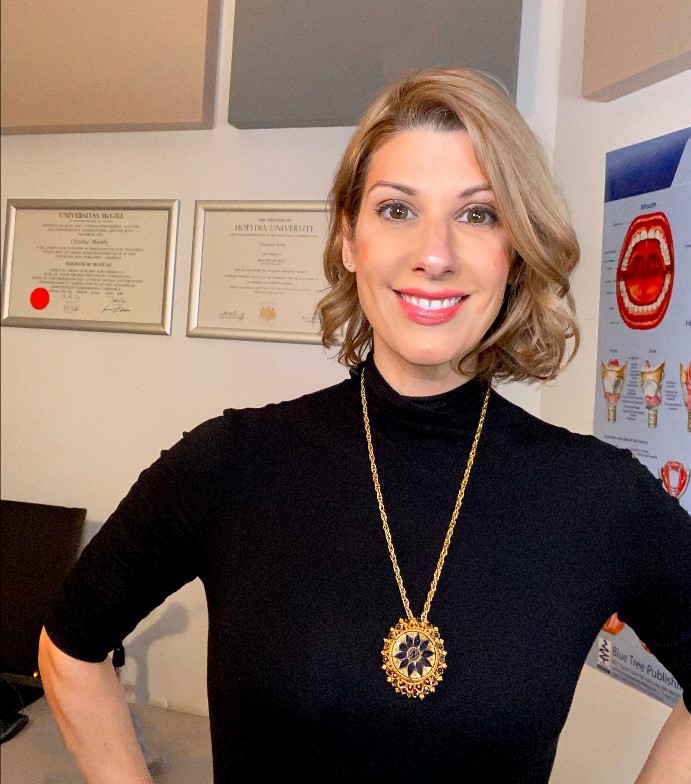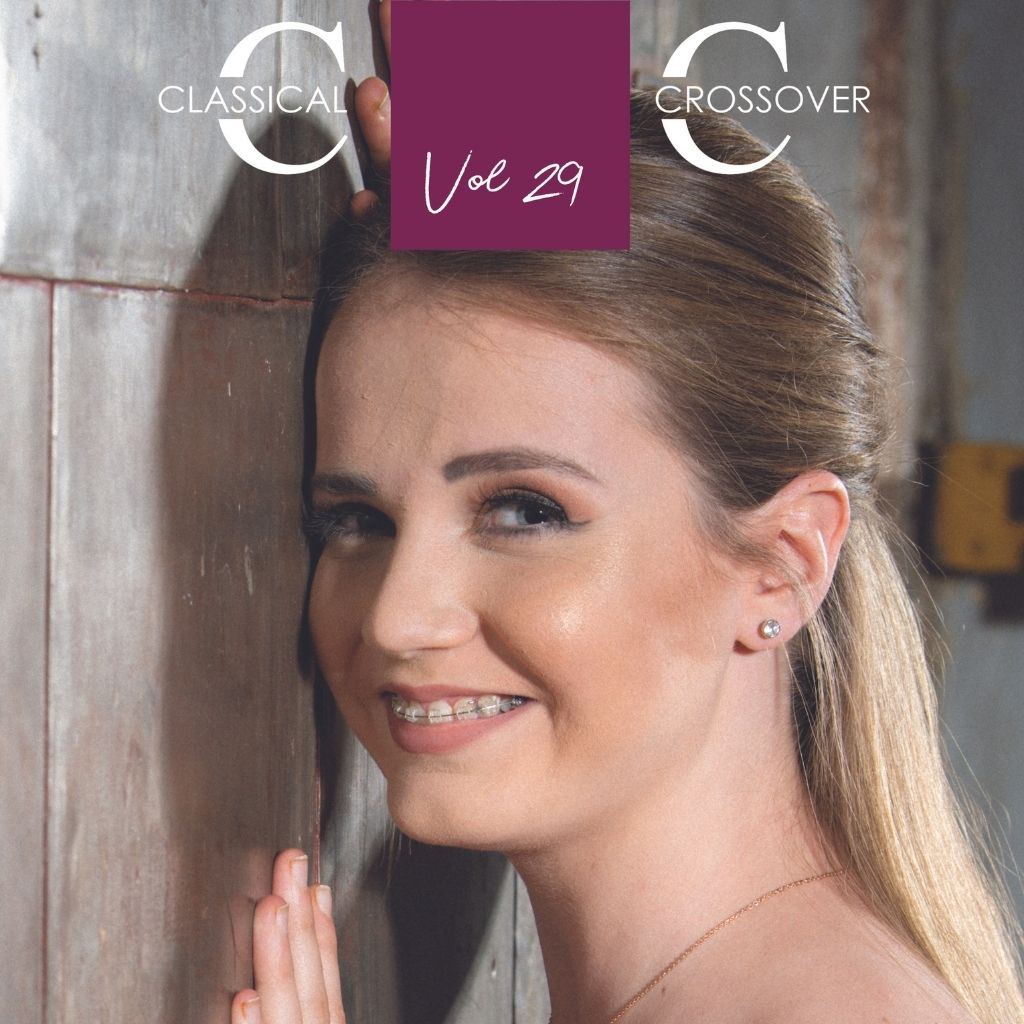Speech-Language Pathologist
Voice and Singing Voice Specialist
Thank you for taking the time to get to know me and the work that I do with performers. I am grateful to have an opportunity to share information about this work that I am so passionate about. I am a speech-language pathologist (SLP) specializing in voice disorders. I began my career as a classical singer and earned a Bachelors Degree in Vocal Performance from the Crane School of Music, and a Masters Degree in Opera Performance from McGill University. Later I decided to change my career trajectory and I went back to school to earn a Masters Degree in Speech-Language Pathology. From my first class, I knew I found my “home” in a way I never quite felt I found on the stage. I’ve worked for the past 11 years at the Sean Parker Institute for the Voice at Weill Cornell Medical College, and I also work per diem for Phelps Memorial Hospital Center in Sleepy Hollow, NY. I’m a resident of Westchester County, and I appreciate having a connection with my local community, along with keeping up my work in Manhattan. When I’m not working, I am enjoying time with my 2 beautiful children, doing yoga or other forms of fitness, and enjoying everything outdoorsy and fun about New York.
CCM: How did you first become involved in music?
Christine Murphy Estes: I’ve always been singing, for as long as I can remember. As a child I would hear songs and be able to sing back the melody immediately, go to a piano and figure out the melody there, and make up my own songs. My mother always sang to my brother and I and she has a beautiful voice. Music was always playing in our home. It wasn’t classical music. It was Irish music and The Beatles and then country music because we only had the country music video station for a long time. As I got older, it was clear that I had an ear for music and I had talent. I first learned to play the clarinet, but singing was more my passion. Singing was a way I could express myself when, otherwise, I was a rather shy person.
CCM: What were some of the highlights you had as a performer?
Christine Murphy Estes: For me, recital feels like the heart and soul of music, far more than the operatic stage. I loved formulating a recital program, working with a collaborative pianist, and creating something special. That type of collaboration, where the piano is not accompaniment, but its own voice and character, is true art to me. Similarly, the song texts start to feel like a blend between a character and my own experiences. Recital is small and intimate and meaningful. I’ve loved every performance I’ve been involved with, and at any given time if you asked me for my favorite I would say, “What I’m working on right now,” but my heart is truly with lieder and chansons and interesting recital work.
CCM: When did you first consider voice therapy as a career?
Christine Murphy Estes: For a long time I questioned if a singing career was really for me, but I first learned that voice therapy was “a thing” when I was a temp for a communication disorders department in between semesters at McGill. I had a few opportunities to observe speech-language pathologists and I was fascinated. They didn’t specialize in voice disorders and were more focused on speech, articulation, and language disorders, but it stuck with me. After that, I felt like I kept hearing about speech-language pathology, and then I learned that voice therapy was a specialty. I asked several voice therapists if I could observe their work and so many of them were generous with their time in allowing me to sit in on their sessions. It truly felt like home to me.
CCM: Did you have any reservations about changing career paths and returning to school?
Christine Murphy Estes: I think any career change comes with fears and reservations. Singers invest a great deal of time, money, and energy on their craft, and when you have given that much of yourself, it’s not an easy choice to change directions. Also, the voice is so closely linked to our identity and personality. It took me a while to feel confident that going back to school was the right choice for me. What if I stuck it out? What if the “big break” was just around the corner? At a certain point, though, it became clear to me that I was not going to be happy, even if I ended up where I once expected I would be. My dream had changed. I also worked closely with a counselor during that time and therapy helped me work through a lot of my conflicting feelings. Once I took my first class in speech-language pathology, I didn’t look back, and I can truly say I don’t have any regret whatsoever. I’m passionate about what I do.
CCM: What is your favorite part about being a speech- language pathologist?
Christine Murphy Estes: My favorite part is also my least favorite part – the day that my patient and I agree that it’s time to end therapy. It’s a bittersweet moment because, on one hand I am proud that my patients feel a sense of agency over their voice and that they have recovered from, or learned to successfully navigate their way through a voice problem. On the other hand, during the course of voice therapy you get to really know your patients and they trust you with their voices, which can be a vulnerable feeling for them. You learn about their lives, their goals, their fears. It’s a wonderful thing. So on that last day, I’m sad because I know I will miss having their energy in my office. Fortunately, most of my patients are great at keeping me updated on their upcoming performances, so I get to celebrate them as a fan!
CCM: What are some of the different types of patients you work with?
Christine Murphy Estes: I work with individuals with a variety of voice and upper airway disorders. The primary group of patients I see are occupational voice users, many of whom are singers from hobbyist to student to established professional, but I also see a lot of teachers (they have the HIGHEST prevalence of voice injury, believe it or not), fitness instructors, worship leaders, lawyers, salespeople… really anyone who uses their voice extensively for a living. I also work with people who have neurogenic voice disorders, such as vocal fold paralysis or nerve weakness called paresis, breathing issues, chronic cough, exercise induced laryngeal obstruction, and voice change related to aging.
CCM: Has being a speech-language pathologist changed the way you approach singing?
Christine Murphy Estes: Without question, my perspective has changed in so many ways. I think any time we are in a position to analyze other people’s voices, whether it be as a voice teacher or voice therapist, we learn a little more about our own voices. Sometimes in therapy I’ll say something to a patient and have a little “AHA!” moment because it reminds me of something one of my voice teachers said years ago that I never fully understood.
Also, being a graduate of a classical voice program, I began my career as an SLP with a great deal of classical bias, assuming that musical theatre performers had poor technique, that they all needed to have classical voice training, and that belting was injurious to the voice. Considering that anywhere from 50-70% of my practice at any time is made up of musical theatre singers, it’s a good thing that I learned otherwise and confronted that bias. The demands simply aren’t the same between different styles of singing.
CCM: Vocal injuries are often accompanied by a lot of shame that wouldn’t come with other physical injuries in sports for example. How do you deal with this and encourage your patients?
Christine Murphy Estes: It can be tricky to navigate this issue when someone is diagnosed with a voice disorder, so I spend a great deal of my time educating college voice programs and the voice community on different types of voice problems and how they arise, along with dispelling the notion that it’s all about “bad technique.” Sure, there ARE people asking too much of their voices without the training to properly handle it, but this represents the minority, not the majority, of the treatment population I see. I love that you bring up sports, because I talk about it all the time. Athletes play hard and play often. If they get injured, it’s not called “bad football technique.” They go through treatment (medical, therapeutic, and/or surgical) and they generally recover. Vocal athletes ask a lot of their voices and sometimes things happen. The more we talk about it and normalize it, the less stigmatized it becomes. All of that fear and stigma only keeps people from seeking the help that they need because they are afraid of what the answer will be.
CCM: Do you have a typical day schedule?
Christine Murphy Estes: My schedule is EXTREMELY variable. Some days I am in the clinic with our brilliant laryngologists and I might be getting case histories from the patients, performing videostroboscopic examinations (“scoping”), running acoustic and aerodynamic testing, and providing counseling to patients to prepare them for voice therapy or other treatments. Sometimes I’m doing what’s called “stimulability,” which means trying voice therapy techniques out on the spot during their exam to see how they respond and if we can hear and see a noticeable change. Some days I am treating my own therapy patients and, again, my caseload is always mixed and keeps me on my toes. And I also have some time dedicated to research. I think clinical research is extremely important. The field of voice medicine is relatively new in comparison with other medical specialties, and because of that, there are still many studies needed to help us improve how we diagnose and treat our patients. A lot of valuable research comes from us paying attention to beliefs about the voice that seem to be cemented into belief simply because they have been repeated enough, but they haven’t been studied. I am engaged in several studies each year with the goal of improving our practice.
So that’s the long answer… the short answer is, NOTHING is especially typical about my schedule as a voice therapist and I like it that way. I’m constantly learning and growing and challenged, and that is incredibly motivating.
CCM: Do you recommend any specific programs, shadowing, etc. if someone is interested in becoming a speech—language pathologist?
Christine Murphy Estes: There are many ways to learn about the work that a speech-language pathologist does, and it’s important to keep in mind that this field isn’t only about voice. In school, the SLP takes classes on child language disorders, articulation and phonatory disorders, fluency/stuttering, auditory disorders, stroke and traumatic brain injury, swallowing disorders, so many things beyond voice. There are many opportunities to engage with the community and explore our field. The website for the American Speech-Language Hearing Association (ASHA) has a ton of good information and resources. For a voice specialty, specifically, there are many organizations, such as The Voice Foundation and the Pan American Vocology Association that share a great deal of information. There are a large number of voice conferences each year (The Fall Voice Conference, The Voice Foundation Symposium, The Pan American Vocology Association Symposium, The Voice Therapy Conference), websites from fellowship-trained laryngologists (that’s an ENT who specializes in voice) and other voice therapists, and social media accounts for voice therapists out there. Reaching out to professionals and asking if you can observe can be a great way to witness “a day in the life” of the voice therapist. But one thing that is equally important as it is daunting – start reading peer-reviewed scientific literature about voice. That’s where the data comes from and, while at first it can be intimidating to read, it gets easier and easier the more you read it.








